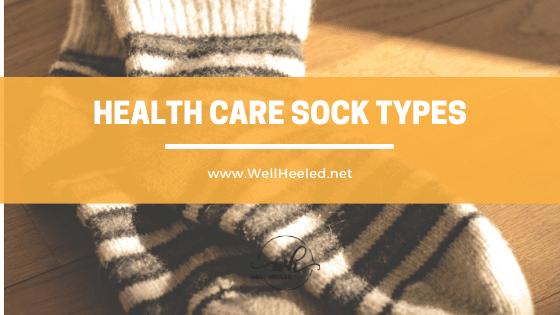What are the Different Types of Socks Used in Health and Social Care?
Health Care Socks Introduction
As we walk through life, we tend not to give our socks a moment’s thought. However, most of us don’t realize that our socks can significantly benefit our feet and overall health. That is why podiatrists have been developing unique varieties of socks so that there is a speciality sock for every person who might require a little more from their everyday socks. For example, people with blood flow issues, diabetes, or surgery recovery benefit greatly from investing in specialized socks. Well Heeled takes a quick look at these different types of socks.
What are the Different Types of Socks Used in Health and Social Care?
When it comes to specialized medical socks, the socks that are most prescribed and sought after are:
- Health socks
- Compression socks
- Diabetic socks
Each of these has been specially designed to offer support for specific medical issues, and they can help minimize discomfort when worn regularly. The best-suited sock for a person with health complications relating to their feet will depend on their needs.
Health socks
Health socks have been designed to offer increased comfort and protection in order to prevent foot-related issues such as swollen feet, blisters, and Deep Vein Thrombosis (DVT). In addition, these socks have been specially designed to keep the feet comfortable and dry.
Who are health socks for?
They can be purchased without a prescription, and they are suitable for those without feet problems, too. In fact, wearing health socks every day can help prevent problems later on.
Pregnant women specifically benefit greatly from health socks since they offer support and reduce swelling without providing too much pressure on the feet. In addition, people who spend a lot of time on their feet also benefit from these socks. They will find that their feet don’t ache as much, and they don’t feel as tired after standing for long periods.
Compression socks
Compression socks are specially designed to offer increased pressure to the feet and lower legs to better blood circulation in the feet and legs.
There are three kinds of compression socks: anti-embolism stockings, nonmedical support hose, and graduated compression socks. Graduated compression socks are the most commonly used compression socks, since they don’t require a prescription and are suitable for everyone.
These socks help minimize blood circulation problems, and so, people who wear them will notice that they have increased blood flow in their feet and lower legs.
Who are compression socks for?
These socks are ideal for anyone who feels that their lower legs and feet need increased blood circulation. For this reason, these socks are trendy amongst pregnant women, pilots, and athletes. People can also wear them without any foot-related issues, but it is advised that they only be worn if they fit correctly. Wearing compression socks that are too tight or ill-fitting can lead to great discomfort.
Diabetic socks
Unfortunately, diabetes can lead to significant health complications, including decreased foot health. In order to minimize the health complications that diabetes can have on the feet, podiatrists have designed diabetic socks. These socks offer support, increased blood flow, and padding to reduce injury and potential nerve damage.
Who are diabetic socks for?
As the name would suggest, these socks have been designed with the requirements of those with diabetes in mind. However, not everyone who has diabetes might need these socks. For example, people with diabetes who haven’t found any foot-related complications won’t need the socks. However, wearing these socks can help avoid future complications by minimizing the risk of injury to the feet. People with diabetes need to check their feet daily for any signs of infection, injury or decreased blood circulation.
The following people with diabetes will benefit from wearing diabetic socks daily:
- Someone who has noticed a change in the colour of the feet
- Someone who has a tendency to get fungal infections, blisters, or nerve damage on the feet
- Someone who is at risk of developing peripheral arterial disease
- Women with gestational diabetes
How do you choose the right socks?
The best socks for your feet will depend on whether you have any foot-related complications or not.
Health and graduated compression socks are good options for those who want to give their healthy feet solid support while staying comfortable. Be sure to fit the socks carefully. They should be the correct size to avoid any discomfort. People with healthy feet should avoid anti-embolism stockings and diabetic socks since these socks have been medically designed to offer increased pressure and support. This might be too much for healthy feet and may result in cramping the feet or lower legs.
Pregnant women can choose between health or compression socks. However, women who have been diagnosed with gestational diabetes may benefit from wearing diabetic socks since these socks will also offer increased blood circulation, which might be lacking.
People recovering from surgery will also benefit significantly from wearing specialized socks. For this reason, it is common for podiatrists to either recommend or prescribe socks that will help with recovery.
Immobile people should be wearing socks that can offer sufficient blood circulation while minimizing the risk of infection. In this case, a discussion with your podiatrist is the best way to choose the best socks.
The importance of good foot care
These socks are outstanding at offering us extra support and comfort. However, they can’t be expected to solve all foot-related problems. Therefore, you must practice good foot care daily. Whether you have foot-related health problems or not, be sure to do the following regularly:
- Wash and dry the feet thoroughly
- Keep the feet moisturized
- Check the feet for any signs of infection or nerve problems
- Treat foot injuries and infections with care
- See a podiatrist if there is any significant change in the appearance of the feet
Conclusion
Establishing good foot care is essential to having good foot health. By assessing the needs of your feet and lower legs, you will be able to get the perfect socks that can give your feet the support they need.



